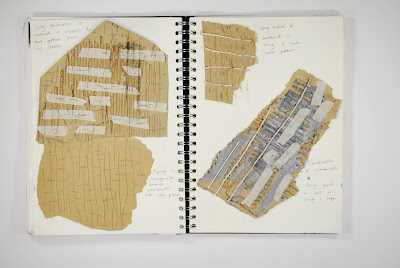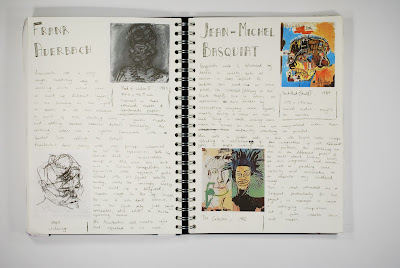The first project I undertook on Foundation Art & Design was the constructed drawing project. The aim of the project was to become familiar with using materials in both conventional and non-conventional ways and to challenge our perception of drawing. We used cardboard, tape, black and white paint and string, as well as other materials, to construct a piece in 3D or low-relief inspired by our initial drawings from the embankment.
To start this project, we went to the embankment in Bedford to take sketches of the area, focussing more on how the landscape was constructed in terms of composition, perspective and tone rather than sketching out perfect trees etc.
 |
| Two pages of my initial drawings from the embankment |
I made drawings of individual objects, such as a bin, a section of railings or a particular tree, as well as choosing more varied sections of the landscape in general. I made sure to record depth and perspective in my drawings by making heavy, darker lines to show when an object was in front of another and sharper lines for lighter or more detailed areas. I had four pages of these drawings before starting my constructed piece.
I also took photos of the areas I drew for further compositional reference.
 |
| One of my photos |
When starting our constructed pieces we had a choice of a small, medium or large piece of cardboard to use as a starting point; I chose the largest so I had more room to work with when constructing. This proved to be a good decision as after thinking about the piece for a long time I decided to get right into it and started ripping sections of the cardboard off - after ripping bits off I still had a large area to work with.
After ripping into it I could start to see a tree-like shape forming so I used this as a starting point for my plan, trying to incorporate a specific tree I drew which had an interesting twisted shape which highlighted light and dark areas. When planning, I found there were certain parts of my drawings that I thought would work well with the piece so I tried to add them into the composition too, whether it was a certain shape or a certain texture.
I was unsure where to start with my constructed piece so I tried to create light and dark areas, like the 'twisty' tree I drew, with paper, after briefly experimenting with it in my sketchbook. This was unsuccessful so I took it off. After this, I became more thorough with trying things out in my sketchbook before using it on my constructed piece, as shown in the photo below.
 |
| My experimentation of trying to achieve a bark-pattern from a tree I drew |
After tearing into my piece again I started to become more focussed and confident on what I was constructing, again being guided by small, rough plans I made in my sketchbook, as well as by the artist research I did. I researched Frank Auerbach, Jean-Michel Basquiat, Claude Heath and John Virtue. I wanted to build up layers to achieve a sense of low-relief as well as playing with perspective through the incorporation of a railings-inspired section.
 |
| Part of my artist research |
My piece became three different sections; the middle section was taken from a tree I drew, with masking-tape and string used to create its distinctive bark-pattern, as well as watered-down black and white acrylic paint, a fine-liner pen and black paper. The building up of 'messy' layers to try and create and 'find' a certain texture was something I could relate to Auerbach and Heath.
 |
| The 'middle' section of my piece |
The section to the left of the middle piece was the 'twisty' tree that I had initial wanted my piece to be centred around. After trying to use paper on the cardboard to create its light and dark twists, I instead decided to construct it separately out of white cardboard and brown cardboard, with black paper also used for darker areas. I then attached this to the middle section. The strips of cardboard used for this section worked really well with building up layers and the use of the lighter strips on the darker strips is reminiscent of Virtue's paintings.
.JPG) |
| The 'left' section of my piece |
The section to the right of the middle was where I introduced a sense of perspective; after trying and failing to construct the railings I drew, I instead decided to simply have a railings-inspired line of cardboard covered in black paper, which would get thinner as it went away. As this took the eye away from the rest of the piece, I added another strip to return to the work. This section gives the impression of distance.
 |
| The 'right' section of my piece |
Towards the end of constructing my piece, I decided to add scrunched up balls of cardboard to act as leaves on the middle tree, as I didn't feel that I had made the most of experimenting with the cardboard itself.
 |
| The string 'stitching' |
 |
| The scrunched up cardboard 'leaves' |
Once finished, I arranged my piece on the wall so that the 'left' and 'right' sections would stick out slightly, creating a slightly curved piece. Below is my finished, constructed piece.
I think the strengths of the piece are the use of perspective with the 'railings', as well as the building of layers throughout my piece. I think the weaknesses of the piece are the lack of overt 3D sections and if I could do this project again I would try to be more adventurous with the materials, instead of just trying to mimic certain textures or patterns. However, I'll go away from this project with more confidence with larger pieces, getting right into it, as I did by initially ripping into the cardboard and not being too scared by it.

.JPG)

No comments:
Post a Comment